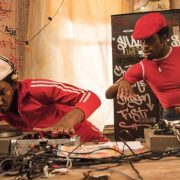How are we to achieve a state of spontaneous order in our society? Let’s take a lead from scientific researchers.
Sharon Glotzer is a scientist who has made a number of discoveries that, in her words, “completely change the way you look at the world”.
Changing the way we look at the world is exactly what we all need to do in order to appreciate the potential for spontaneous order in society. So let’s listen to Sharon Glotzer’s story.
Studying Emergence.
She studies emergence – the phenomenon whereby complex systemic order results from the undirected individual behaviors of multiple participants. Starlings flying in complex ordered patterns in the sky is one example she cites, as does Steven Strogatz in talking about Sync. How are those birds communicating so that it seems like they are all following a blueprint?
Glotzer is searching for fundamental principles that govern this emergence of ordered patterns from seemingly random microscopic interactions and arrangements. She found a method: computer simulations.
The Answer Is Entirely Counter-Intuitive.
She discovered something entirely counter-intuitive. In scientific terms, she expresses it this way: entropy, a concept commonly conflated with disorder, can actually organize things. Her example is simple pyramidal shapes called tetrahedra spontaneously assembling into a quasicrystal, a super-complex spatial pattern. The shapes organize themselves – because, in conditions of entropy, “there are no direct interactions, no charges, no nothing” to direct them. In entropy, the particles have no constraints, and therefore more options to arrange themselves. They “wiggle around” freely to find their best position and orientation and alignment. The outcome is “the most complicated entropically stabilized structure that anyone has ever seen”.
Wow!
From The Lab To Society.
Let’s see if we can translate this from the lab to society. Scientists used to believe that entropy results in disorder. Entropy in society could be characterized as no government, no central control, no rule-making intermediaries, no hierarchies, no central planning, no social engineering.
As Professor Glotzer says, this way of thinking creates a complete change in the way we look at the world. We are conditioned to think of the organization of our world in terms of hierarchy and central control. Someone, or some piece of legislation, or some institutional rule is always telling us what to do and how to line up. There is hierarchy in government, hierarchy in religious institutions, hierarchy in corporations, and hierarchy in families.
In a world of social entropy, there would be no such control.
The Method Is Inverse Design.
We are told that such a world is impossible. They call it anarchy, the absence of social order. But Professor Glotzer’s research tells us the opposite. Without central direction, and just a few general rules that apply to all, her particles find “wiggle room” – i.e. individual freedom – and self-organize into a complex order that provides the best result for each of them: the preferred amount of space and the optimum alignment.
How did the system achieve this self-organization? Professor Glotzer calls it inverse design. Don’t try to design a process to achieve the desired outcome. Leave the particles alone and, using their wiggle room, they’ll get to the best outcome by their own devices.
The equivalent in society would be to get rid of all social engineering, well intentioned but harmful legislation, central planning, and hierarchical structures. How can we do this? Like Professor Glotzer, we need a laboratory where we can run simulations. It’s probably small, and protected, and a place where it’s possible to think differently and experiment with new forms of organization and entropy.
Tony Hsieh Is Applying The Method.
Tony Hsieh is the CEO of Zappos and he has famously been experimenting with just such organizational innovation in his company. In place of hierarchy, Zappos distributes decision-making in self-organizing circles, in which members have roles (often several at a time) rather than via hierarchy, job descriptions and titles. There is no manager to instruct individuals on their place in the organization. The structure is continuously changing (“50 times a day”, said Hsieh, in an interview with McKinsey (MckInsey Quarterly, Oct 2017)). It’s self-organization.
The general rules are (1) culture and values, (2) purpose, (3) market-based dynamics (meaning the organization is a market-based system). Each member has an entrepreneurial mindset for operating in the organizational market.
Tony Hsieh says he is comfortable with the fact that he does not know which way the ship called Zappos is headed. It steers itself. He rejects linearity and rigid structure. His mantra for organizational experimentation is, “Is it safe enough to try?” Zappos provides us with a real-life example of changing the way we look at the world, and of organizational entropy producing complex order.
Glotzer, Hsieh and Hayek.
Both Sharon Glotzer and Tony Hsieh are bringing to life the spontaneous order theory of Friedrich Hayek in Individualism True and False:
“…the spontaneous collaboration of free men often creates things which are greater than their individual minds can ever fully comprehend.”
How do we achieve spontaneous order in society? We need more thinkers like Sharon Glotzer and more doers like Tony Hsieh. In combination, they will change the way we organize our world.
(An interview with Professor Sharon Glotzer by Natalie Wolchover appeared originally in Quanta Magazine in March 2017.)













